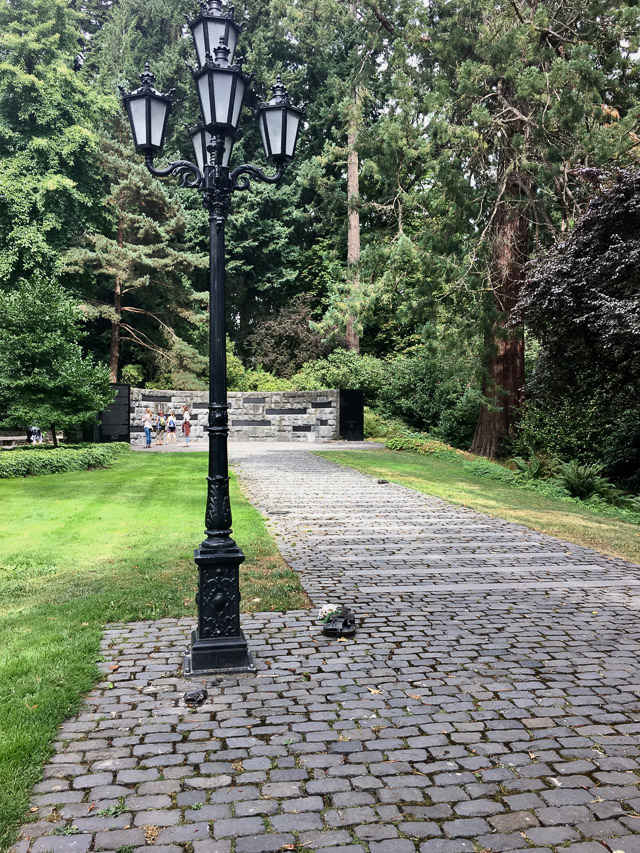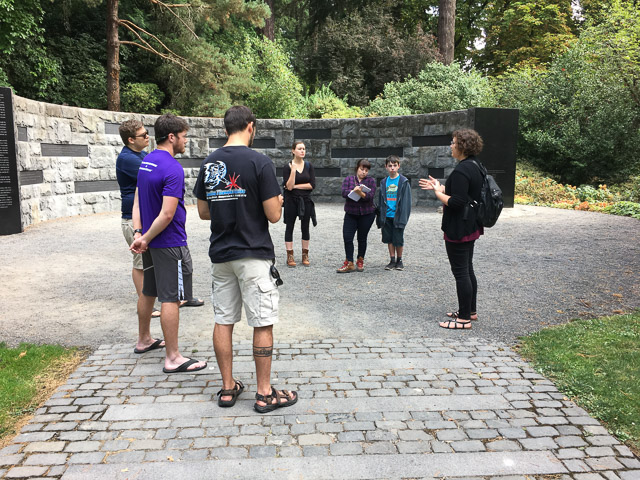This fall my social studies methods class at the University of Portland will work with the Oregon Jewish Museum and Center for Holocaust Education (OJMCHE) to design curriculum for the Oregon Holocaust Memorial in Washington Park here in Portland Ore. With historical memorials in the news and neo-Nazis on the march, this community-based challenge will allow my students to use a PBL approach to explore instructional design with purpose. The lessons learned will serve them well in their careers as secondary social studies teachers.
“Why do we build memorials? Why/ what do we need to remember?
~ Nancy Guidry, student.
My students will team with OJMCHE Holocaust Educator, April Slabosheski to create lessons to support middle and high school visits to the Memorial. I invite readers to follow our progress here and at our class blog. We welcome your advice, suggestions and encouragement.
After our first visit to the memorial I invited students to share their reactions:
- Imagine a primary source account for each of the lost belongings – baby’s shoe, broken violin, abandoned suitcase, baby doll telling the story of a childhood ripped away. ~ James Bayless
- What is truly amazing is how a carefully architected combination of stone and aluminum can evoke such strong emotions (i.e. sadness, fear, anger, etc.). I didn’t know any of those names engraved upon the dark grey stone wall, but I shared part of their suffering and pain by merely reading their names and imagining their circumstances. It became evident to me that we humans are truly all connected– this connection stretching across time, place, ethnicity and circumstance. Amazing. ~ Paxton Deuel
- What struck me the most was probably the simplicity of it. No amount of elaboration would do justice to the horror remembered there, so it seemed appropriate, in a way. ~ Taran Schwartz
- One train of thought that really stuck with me was the idea of reflection. We don’t necessarily always stop and reflect on the buildup of extremely catastrophic events. We tend to merely focus on the event itself. Very excited for this project. ~ Kelly Sutton
- What an exciting opportunity! Should keep the Oregon survivor central- these are people within our community; how far reaching these events were, how connected we are to history. The town square design was particularly powerful; idea that that was where holocaust really started- othering Jews and people let it happen. Idea that the town square is also a place where future things like this can be prevented- people taking to the streets in solidarity, people gathering to talk across differences. ~ Nancy Guidry
More on the Oregon Holocaust Memorial:
The Oregon Holocaust Memorial was dedicated on August 29, 2004. The memorial features a stone bench adorned with wrought-iron gating, screened from the street by rhododendron bushes. The bench sits behind a circular, cobblestoned area – simulating a town square. During the Holocaust, many Jewish families were gathered in town squares before being loaded onto trains and taken to concentration camps. The square contains scattered bronzes of shoes, glasses, a suitcase, and other items to represent everyday objects that were left behind. A European-style, cobblestone walkway with inlaid granite bars, simulating railroad tracks, leads to a wall of history panels – giant, stone placards that offer a brief history of the Holocaust and quotes from Holocaust survivors. At the end of the wall is the soil vault panel. Buried below the panel are interred soil and ash from six killing-center camps of the Holocaust – Chelmno, Treblinka, Sobibor, Belzec, Majdanek, and Auschwitz-Birkenau. The back of the wall is engraved with the names of people who died in the camps, followed by the names of their surviving relatives in Oregon and SW Washington. Source
Image credits: Peter Pappas










